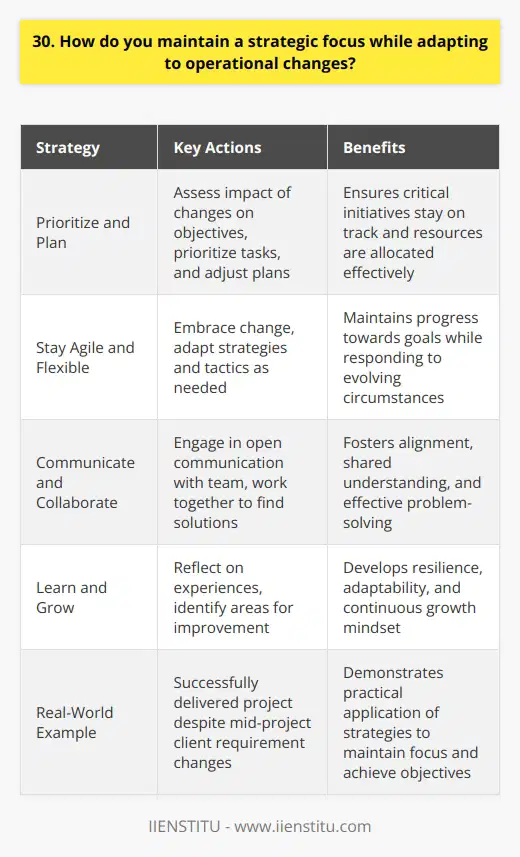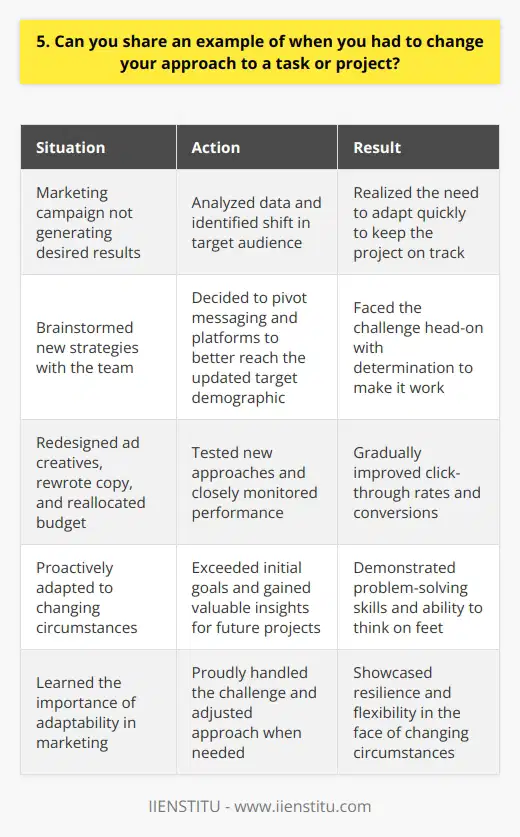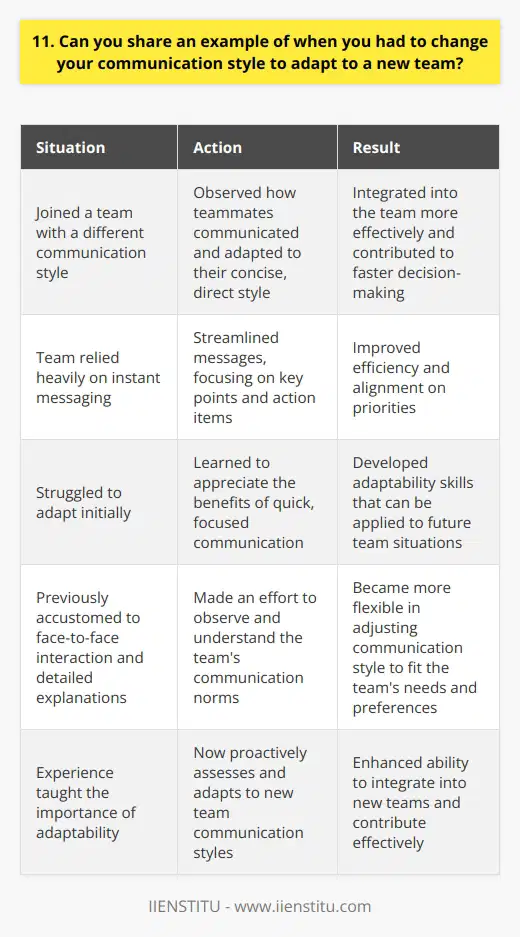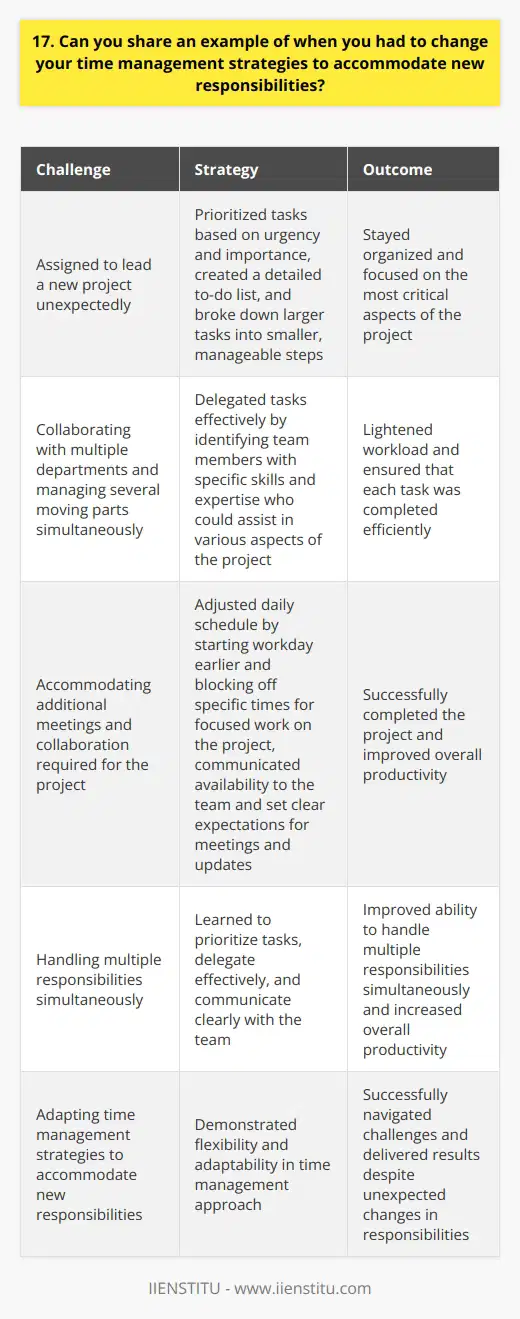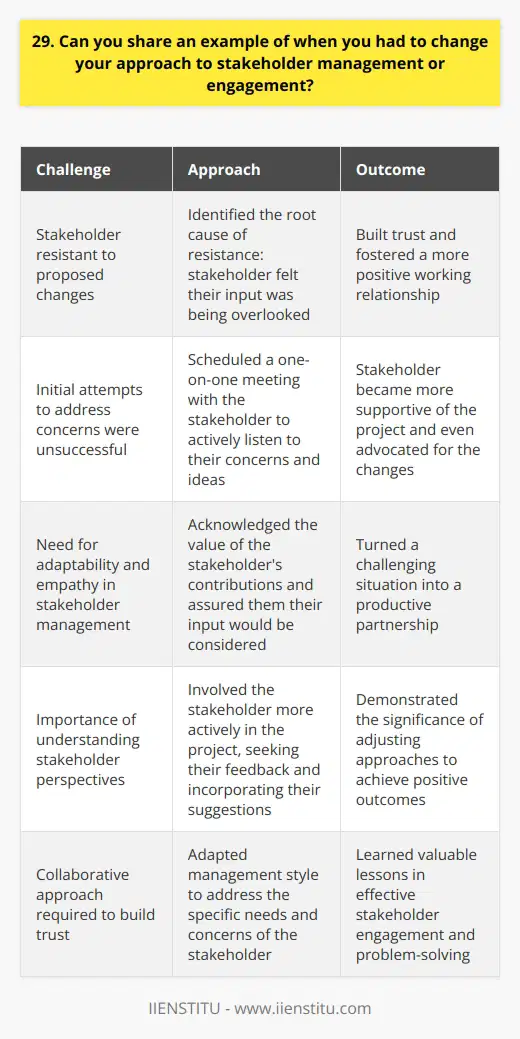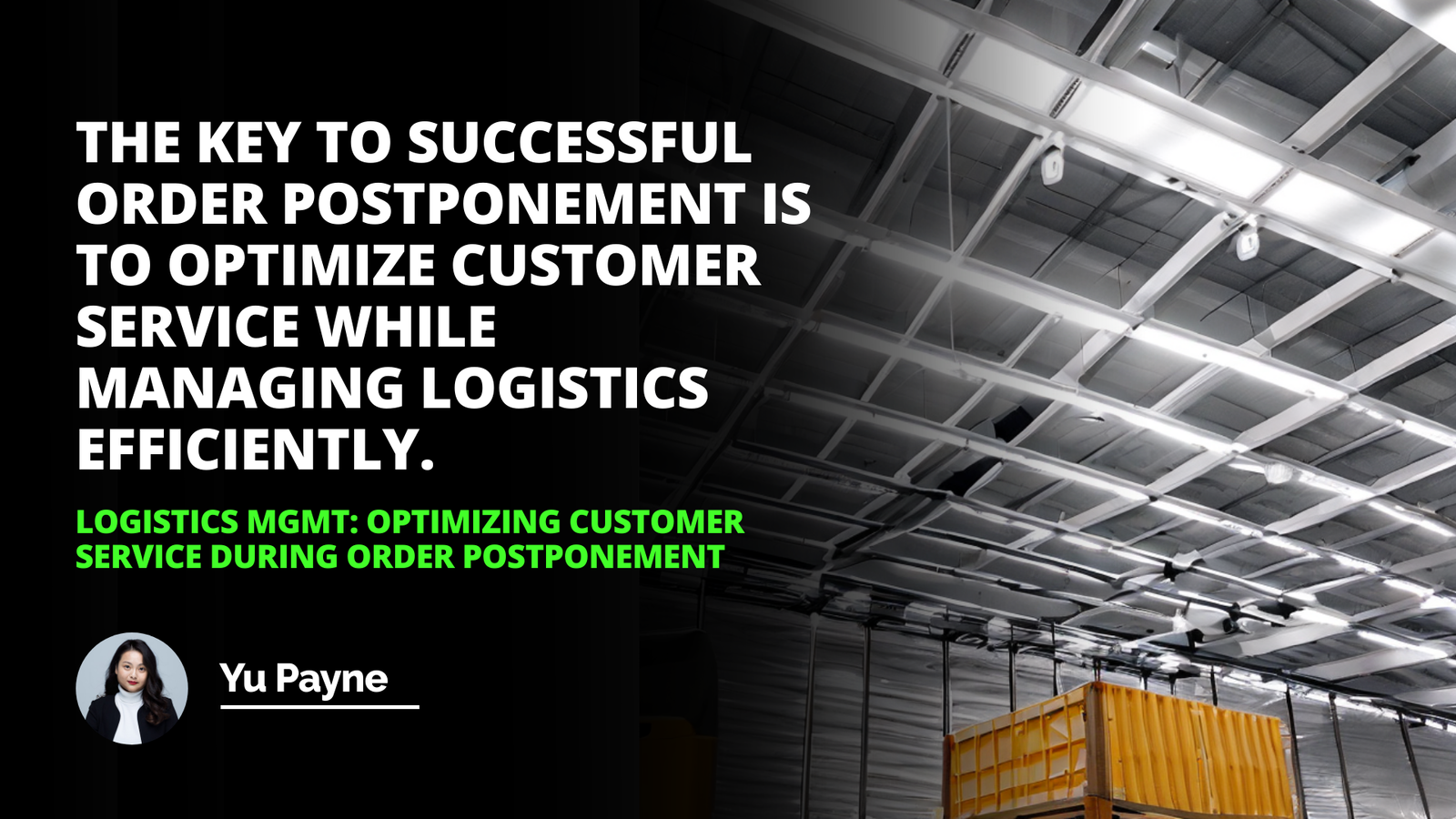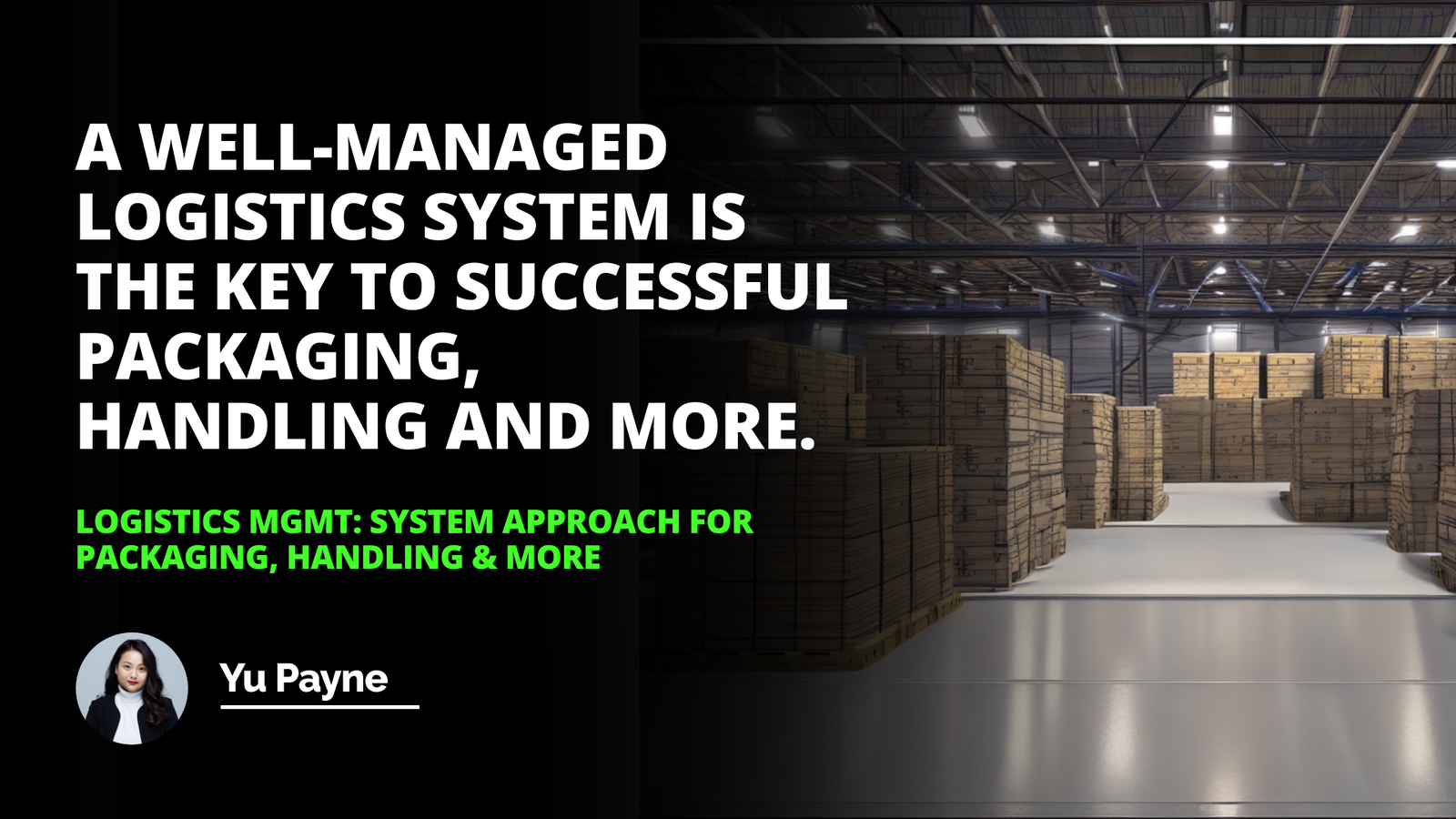
"Have you successfully adapted to a major change?" This question is often asked in job interviews to explore an applicant's flexibility and resilience—two characteristics crucial in today's fast-paced business world.
Employers want to know if you can handle changes efficiently and professionally, whether it's dealing with a difficult client, handling a crisis, or switching to a new role or department. The question addresses your ability to adjust, learn, and grow amidst challenging situations, which is vital in any job setting.
The Purpose of the Question: Have you successfully adapted to a major change?
This question focuses on your adaptability—an essential attribute in any industry. Changes are inevitable, whether it's taking on new job responsibilities, adapting to new technologies, or a shift in leadership.
Related Course: Leadership Development Course
As such, employers look for candidates who can comfortably transition with minimal disruption to their individual productivity and the team's overall performance. Hence, the question aims to gauge your resilience, resourcefulness, and resolve, which are all fundamental to effectively navigate any major change.
At What Interview Level is it Asked?
"Have you successfully adapted to a major change?" is typically asked at every interview level – from entry-level to executive positions.
The depth and details expected from the answer scale with the responsibility accompanying the position. Higher-level candidates might discuss strategic shifts, whereas entry-level candidates can explain changes during their education or previous job experiences.
What Kind of Answer is Expected from the Candidate?
Employers are looking for solid examples demonstrating how you've adapted to a major change. Rather than giving a generic answer, talk about a specific situation where you adjusted to a change successfully.
How To Answer What's Your Top Problem-solving Method İnterview Question
Align Time Management With Long-term Career Objectives İnterview Question
Describe the situation, your actions, and the result. Show you're not just capable of coping with change but thriving amidst it. Share how the experience shaped your work habits or attitude and focus on the lessons you learned.
Possible Answers to Consider
Formulate your response using the STAR technique: Situation, Task, Action, and Result. You could talk about a time when your company underwent restructuring, or discuss when you started a new role in a different field. Describe how you felt about the change, what steps you took to adapt, and the outcome of your efforts.
Here's a sample answer:
"In my previous position, my company went through a major restructuring process that led to a shift in my responsibilities. Initially, I found it challenging, but I quickly saw it as an opportunity to learn something new. I enrolled in some courses related to my new duties, collaborated closely with my team, and managed to not just adapt but excel in my new role."
Remember, answering "Have you successfully adapted to a major change?" compellingly showcases your flexibility, determination, and positive approach to change—traits highly valued in every prospective employee.
Although every change has its difficulties, embracing the new and unknown reflects our ability to thrive in various circumstances.
By expressing how you successfully adapted to a major change, you demonstrate your resilience and willingness to grow—proving to your potential employers that you're a fit not just for the world today but the uncertainties of tomorrow.
Workplace Changes and Employee Adaptation Strategies
Responses to the Question with Interview Level
Effects of Major Curriculum Changes on Student Performance
Similar interview questions:
Have you ever had to adjust to a significant change?
In your life, have you ever been met with a major change that you had to adapt to?
How have you coped with substantial alterations in your life or work setting?
Tell me about a time when you had to make major adjustments due to significant changes.
Could you give an example of how you dealt with a major transition?
How did you navigate a situation where considerable change required you to adapt quickly?
How do you handle big changes that require you to adapt?
How have you responded to a dramatic transformation in your life or work environment?
Can you describe a scenario where you had to adapt rapidly after a major life change?
Have you had the experience of making significant adjustments due to abrupt changes in your life?
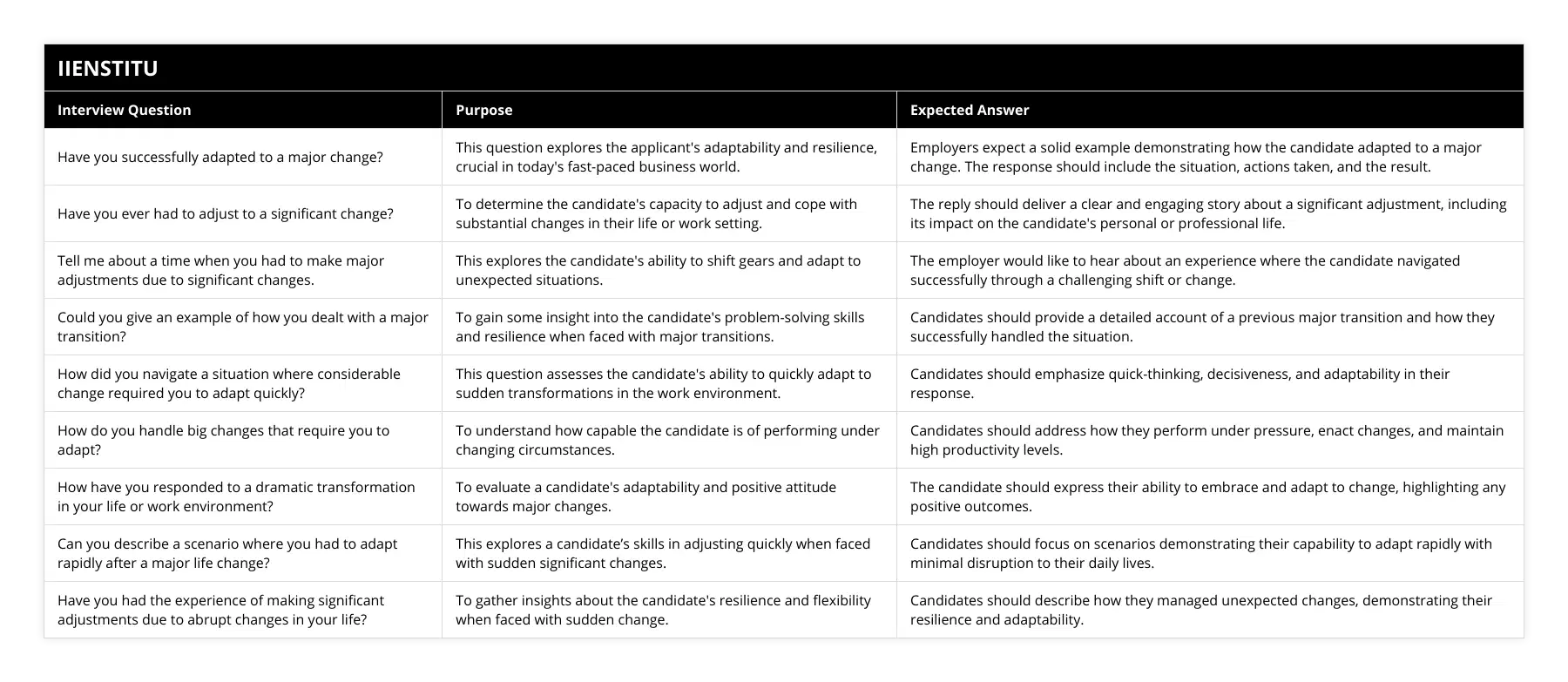
Frequently Asked Questions
1. How do you typically respond to significant changes in your work environment?
I embrace change as an opportunity for growth and innovation. When significant changes occur in my work environment, I take a proactive approach to adapt and thrive.
Stay Informed and Ask Questions
I make sure to stay informed about the reasons behind the changes and how they will impact my role. I'm not afraid to ask questions to gain clarity and understand the bigger picture.
Example:
When my previous company underwent a merger, I scheduled a meeting with my manager to discuss the implications for our department and my responsibilities. By gathering information, I felt more prepared to navigate the transition.
Embrace a Positive Mindset
I choose to view changes as opportunities rather than obstacles. I maintain a positive attitude and focus on the potential benefits, such as learning new skills or collaborating with different teams.
Personal Experience:
When our team switched to a new project management software, I was excited to explore its features and discover ways to streamline our workflows. My enthusiasm helped me quickly adapt and encourage my colleagues to do the same.
Be Flexible and Adaptable
I understand that change often requires flexibility. I'm willing to adjust my work style, learn new processes, and take on additional responsibilities as needed to support the transition.
Example:
During a company restructuring, I volunteered to take on tasks outside my usual scope to help my team navigate the changes smoothly. By being adaptable, I demonstrated my commitment to the company's success.
Communicate and Collaborate
I believe open communication and collaboration are key during times of change. I actively share my ideas, concerns, and suggestions with my team and managers to contribute to a successful transition.
Personal Story:
When our department moved to a new office space, I initiated regular check-ins with my colleagues to discuss how we could optimize our new work environment. By collaborating, we identified opportunities to improve our productivity and well-being.
In summary, I approach significant changes in my work environment with a positive mindset, adaptability, and a willingness to communicate and collaborate. I view change as an opportunity for growth and innovation, and I'm committed to being a valuable contributor during times of transition.

2. Can you describe a time when you had to adjust to a new team or project midway through?
In my previous role as a software developer, I was assigned to a new team working on a critical project with a tight deadline. The project was already underway, and I had to quickly adapt to the team's established processes and codebase.
Understanding the Project Scope and Goals
I scheduled meetings with the project manager and key team members to gain a clear understanding of the project's objectives, timeline, and my specific responsibilities. This helped me align my efforts with the team's goals from the start.
Collaborating with the Team
I actively participated in team meetings, asking questions and offering insights based on my previous experience. I also made an effort to build rapport with my new colleagues, which fostered a positive and collaborative working environment.
Adapting to the Codebase and Processes
I dedicated time to thoroughly reviewing the existing codebase and familiarizing myself with the team's development practices. When I encountered challenges, I proactively sought guidance from experienced team members, ensuring that my contributions aligned with the project's standards.
Contributing and Adding Value
Despite joining midway, I looked for opportunities to add value to the project. I identified areas where my skills could be leveraged to improve efficiency and quality. By taking ownership of specific tasks and delivering high-quality work, I demonstrated my commitment to the project's success.
Adjusting to a new team and project midway through requires adaptability, communication, and a willingness to learn. By proactively understanding the project scope, collaborating with the team, adapting to established practices, and finding ways to contribute, I successfully integrated into the team and played a valuable role in delivering the project on time.
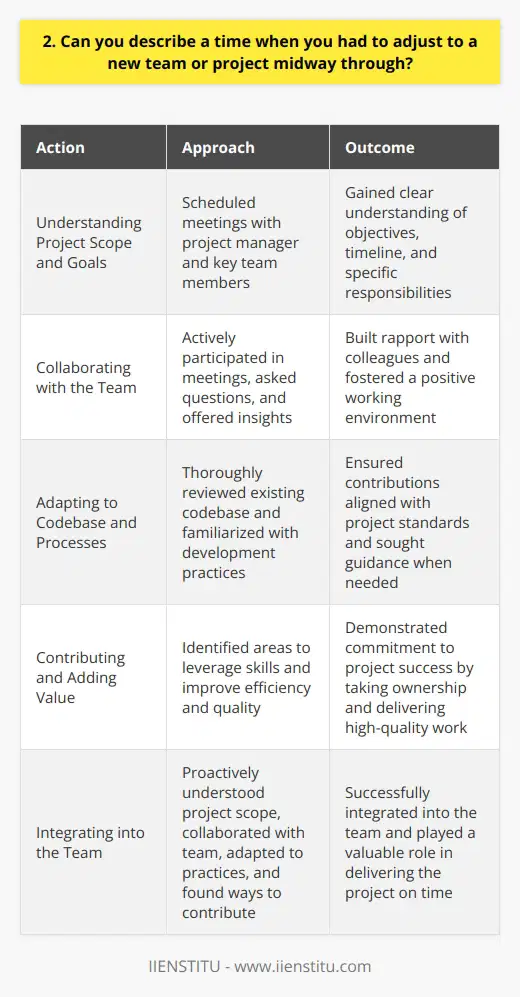
3. Have you ever had to learn a new skill or technology to adapt to a changing role?
Absolutely! In my previous role as a marketing coordinator, I had to quickly adapt to using a new CRM system. It was challenging at first, but I approached it with a positive attitude and a willingness to learn.
Strategies for Learning New Skills
I set aside dedicated time each day to familiarize myself with the software's features and functionalities. I watched online tutorials, read user guides, and reached out to colleagues who were already proficient in using the system.
Applying New Knowledge
As I gained more knowledge, I started applying what I learned to my daily tasks. I made mistakes along the way, but I viewed them as valuable learning opportunities. With practice and persistence, I gradually became more comfortable and efficient with the new CRM system.
Positive Outcomes
Adapting to this new technology not only improved my own productivity but also allowed me to contribute more effectively to my team's goals. I was able to streamline our marketing processes and provide valuable insights based on the data I could now access and analyze.
Embracing Change
Through this experience, I learned the importance of embracing change and being proactive in acquiring new skills. It has made me more confident in my ability to adapt to future technological advancements and take on new challenges in my career.
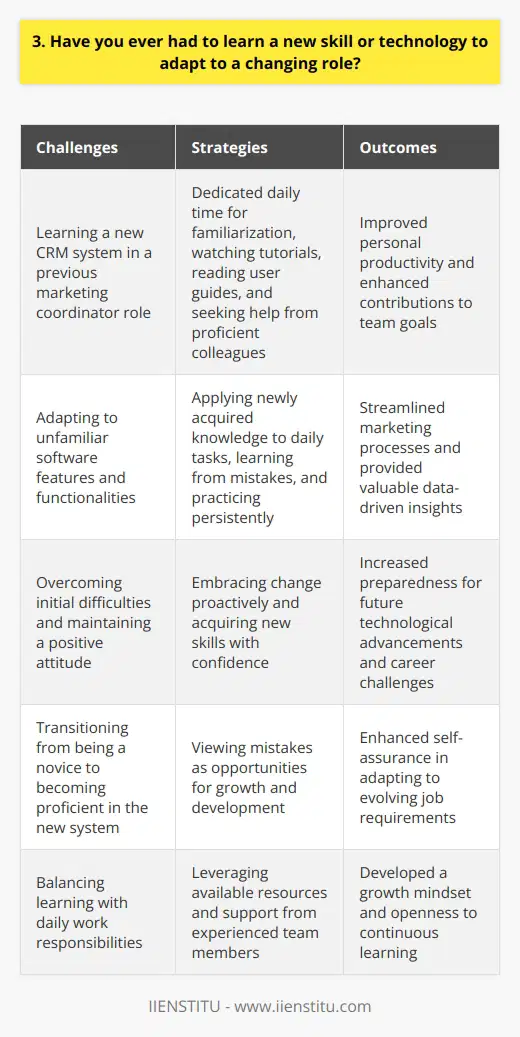
4. How do you maintain productivity during times of organizational change?
Throughout my career, I've experienced several instances of organizational change. During these times, I focus on maintaining a positive attitude and embracing the new direction. I find that approaching change with an open mind helps me adapt more quickly and effectively.
Prioritizing Tasks
When faced with organizational change, I prioritize my tasks and responsibilities. I identify the most critical projects and ensure that I allocate my time and energy accordingly. By focusing on the essential tasks, I can maintain productivity and contribute to the company's goals during the transition period.
Communicating Effectively
Clear communication is crucial during times of change. I make sure to stay informed about the changes taking place and actively participate in discussions with my team and managers. By asking questions and sharing my thoughts, I can better understand how my role fits into the new structure and what is expected of me.
Staying Flexible
Flexibility is key when dealing with organizational change. I remain open to new ideas, processes, and ways of working. If I need to learn new skills or take on additional responsibilities, I embrace the opportunity for growth and development. By being adaptable, I can quickly adjust to the new environment and maintain my productivity.
Seeking Support
During times of change, it's important to seek support when needed. I don't hesitate to reach out to my colleagues, mentors, or managers if I have questions or need guidance. Collaborating with others helps me navigate the challenges that come with organizational change and ensures that I can continue to perform my best work.
In summary, maintaining productivity during organizational change requires a combination of prioritization, communication, flexibility, and seeking support when needed. By approaching change with a positive attitude and a willingness to adapt, I can successfully navigate the transition and continue to contribute to the company's success.
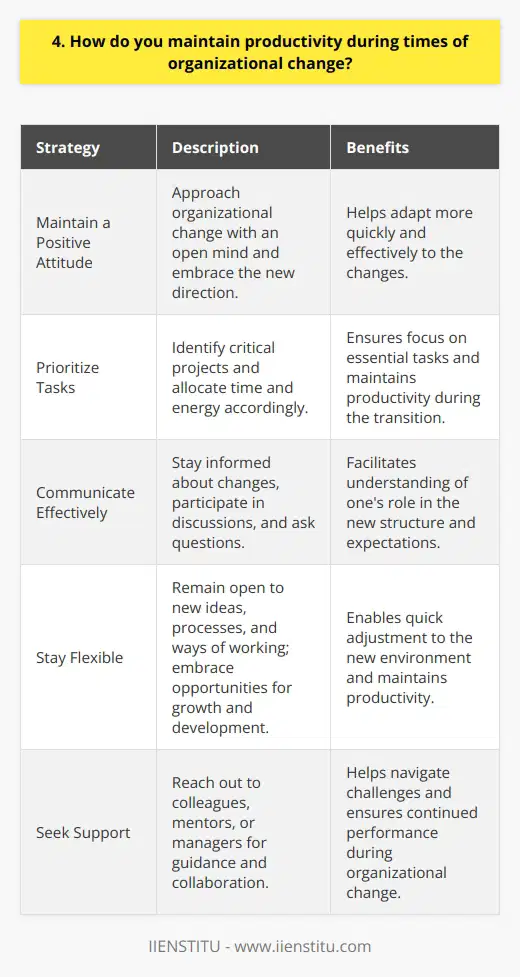
6. How do you handle the stress that comes with major changes at work?
I view major changes at work as opportunities for growth and innovation. While they can be stressful, I focus on maintaining a positive attitude and adapting quickly to new circumstances. Here are some strategies I use to handle the stress that comes with significant changes in the workplace:
Embrace the Change
Rather than resisting or fearing change, I try to embrace it as a chance to learn and develop new skills. I remind myself that change is inevitable in any dynamic organization, and those who adapt well often thrive. By keeping an open mind and focusing on the potential benefits, I find it easier to manage the stress associated with major transitions.
Communicate Openly
During times of change, I prioritize open communication with my colleagues, supervisors, and team members. I ask questions to clarify expectations, share my own concerns or ideas, and offer support to others who may be struggling. By fostering a culture of transparency and collaboration, we can navigate the challenges together and reduce the overall stress levels.
Set Realistic Goals
When faced with major changes, I break down the new objectives into smaller, manageable goals. This helps me stay focused and motivated, while also providing a sense of accomplishment along the way. I prioritize tasks, create action plans, and celebrate small victories to maintain momentum and reduce stress.
Practice Self-Care
To handle the stress of change, I prioritize self-care both in and out of the office. I take breaks when needed, engage in stress-reducing activities like meditation or exercise, and maintain a healthy work-life balance. By taking care of my physical and mental well-being, I'm better equipped to handle the demands of a changing work environment.
In my previous role at a startup, I experienced a major shift in our business model due to market changes. While it was initially stressful, I focused on embracing the change, communicating with my team, setting realistic goals, and practicing self-care. As a result, I was able to adapt quickly, contribute valuable ideas, and ultimately grow both personally and professionally. I believe that by approaching change with a positive attitude and proactive strategies, we can not only manage stress but also unlock new opportunities for success.
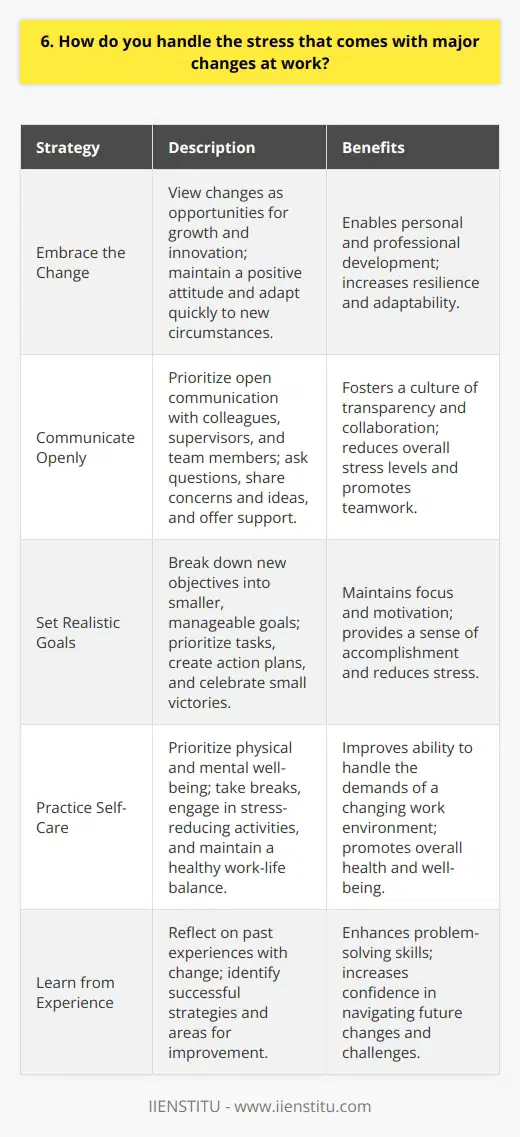
7. Have you ever had to adapt to a new management style or leadership change?
In my previous job, I experienced a significant leadership change when our department got a new manager. At first, I was apprehensive about how this would impact my work and the team dynamics. However, I quickly realized that embracing this change was crucial for my growth and the company's success.
Observing and Adapting
I took the time to observe my new manager's leadership style and communication preferences. I noticed that they valued concise updates and proactive problem-solving. So, I adjusted my approach to align with their expectations. I started providing brief yet comprehensive reports and took initiative in addressing challenges before they escalated.
Seeking Guidance and Feedback
Whenever I was unsure about how to handle a situation under the new management, I proactively sought guidance. I scheduled one-on-one meetings with my manager to discuss my concerns and gather their insights. Their feedback helped me refine my skills and better understand their vision for the team.
Collaborating and Building Trust
I focused on building a strong professional relationship with my new manager based on trust and collaboration. I actively contributed ideas during team meetings and supported my colleagues in adapting to the new leadership style. By demonstrating my willingness to work together towards common goals, I earned my manager's trust and recognition.
Embracing Change for Growth
Adapting to a new management style taught me valuable lessons in flexibility, communication, and professional growth. It pushed me out of my comfort zone and helped me develop new skills. Looking back, I am grateful for that experience as it prepared me to thrive in dynamic work environments.
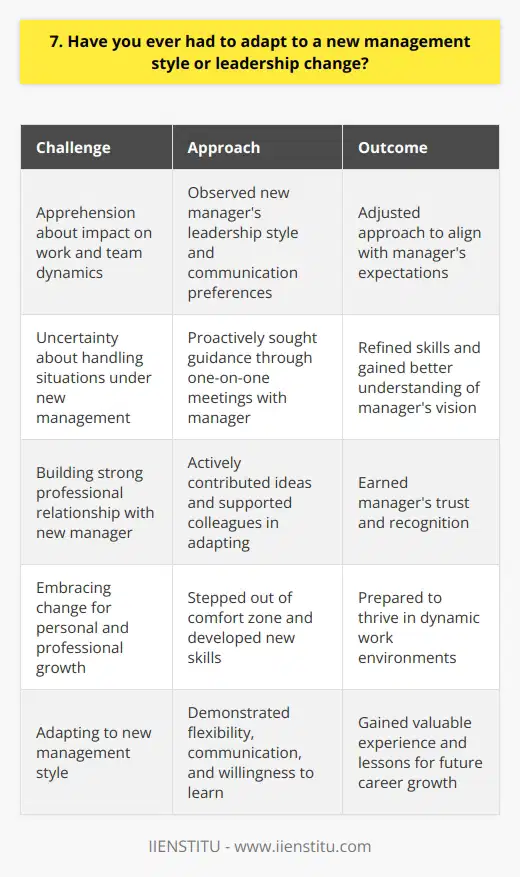
8. Can you describe a time when you had to pivot your strategy due to unforeseen circumstances?
In my previous role as a marketing manager, we faced a sudden budget cut just before launching a major campaign. It was a challenging situation that required quick thinking and adaptability.
Reassessing Our Resources
I immediately gathered my team to reassess our available resources and brainstorm alternative strategies. We knew we had to be creative and efficient with the limited budget we now had.
Leveraging Social Media
One of the key pivots we made was to shift our focus to social media marketing. By leveraging organic reach and targeted ads, we were able to reach our audience effectively without breaking the bank.
Collaborating with Influencers
We also reached out to influencers in our niche and proposed mutually beneficial collaborations. This allowed us to tap into their engaged follower base and expand our reach.
Optimizing Our Content
Another crucial aspect was optimizing our content strategy. We repurposed existing content, created more video tutorials, and focused on providing value to our target audience.
The Results
Through these adaptations, we managed to successfully launch the campaign and even exceed some of our initial expectations. It was a valuable lesson in staying agile and finding opportunities in the face of challenges.
Looking back, I'm proud of how our team came together and pivoted our approach. It demonstrated our resilience and problem-solving skills, which I believe are essential in any fast-paced work environment.
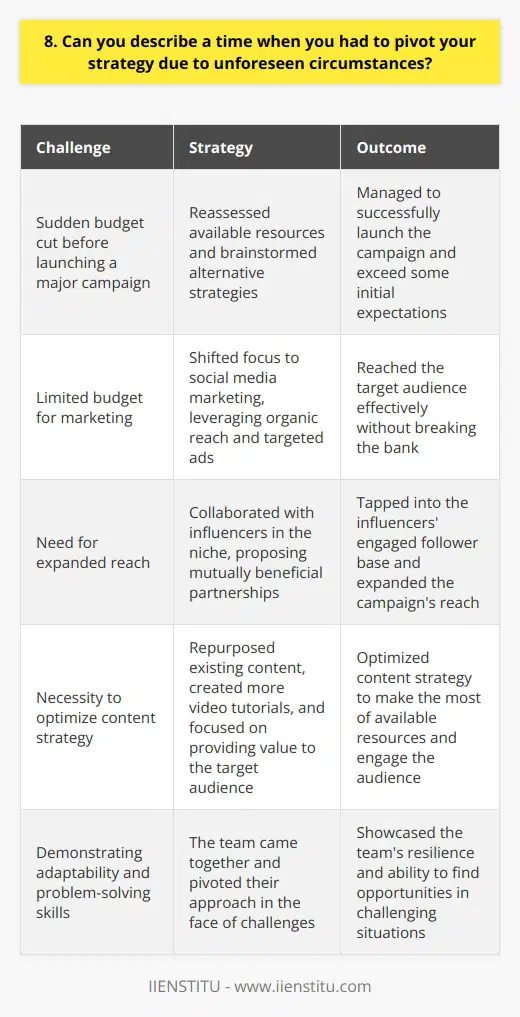
9. How do you ensure that you stay focused on your goals during periods of change?
I stay focused on my goals during periods of change by remaining adaptable and maintaining a positive attitude. I understand that change is inevitable, so I try to embrace it rather than resist it. When faced with new challenges or circumstances, I take a step back and assess the situation objectively.
Staying Organized
One key strategy I use is to stay organized and prioritize my tasks. I break down my goals into smaller, manageable steps and create a plan of action. This helps me stay on track and avoid getting overwhelmed by the bigger picture. I also make sure to regularly review my progress and adjust my plans as needed.
Maintaining Focus
To maintain focus, I eliminate distractions and create a conducive work environment. I set aside dedicated time for important tasks and avoid multitasking whenever possible. I also surround myself with supportive people who encourage and motivate me to stay committed to my goals.
Embracing Learning Opportunities
During times of change, I view it as an opportunity to learn and grow. I actively seek out new knowledge and skills that can help me adapt to the changing circumstances. I attend workshops, read relevant books, and engage in discussions with colleagues to broaden my perspective and find creative solutions.
Staying Resilient
Resilience is crucial when navigating change. I maintain a positive mindset and focus on the things I can control. I celebrate small victories along the way and learn from setbacks. By staying resilient and persistent, I am able to weather any challenges that come my way and stay committed to my long-term goals.

10. Have you ever had to adapt to a significant change in your industry or market?
Yes, I have experienced significant changes in my industry throughout my career. One notable example was when my company shifted its focus from traditional marketing to digital marketing. This transition required me to quickly adapt and acquire new skills to stay relevant in my role.
Embracing Change and Continuous Learning
I realized that embracing change and continuous learning were essential for success in a dynamic industry. I took the initiative to enroll in online courses and attend workshops to deepen my understanding of digital marketing strategies and tools. By proactively expanding my knowledge, I was able to contribute valuable insights to my team during the transition period.
Collaborating with Cross-Functional Teams
Adapting to the shift towards digital marketing also involved collaborating closely with cross-functional teams. I worked alongside our IT department to ensure seamless integration of new marketing technologies. Through open communication and a willingness to learn from each other, we successfully navigated the challenges that came with implementing new processes and systems.
Leveraging Data and Analytics
One of the key aspects of digital marketing is leveraging data and analytics to make informed decisions. I took it upon myself to become proficient in analyzing customer data and identifying trends. By presenting data-driven insights to my managers, I demonstrated my ability to adapt to the changing landscape and drive meaningful results for the company.
Staying Agile and Embracing Innovation
Throughout the transition, I learned the importance of staying agile and embracing innovation. I actively participated in brainstorming sessions and contributed ideas for new digital marketing campaigns. By being open to experimentation and iterative improvements, I helped my team stay ahead of the curve in a rapidly evolving industry.
Adapting to significant changes in my industry has been a challenging yet rewarding experience. It has taught me the value of lifelong learning, collaboration, and staying adaptable in the face of change. I believe that these experiences have equipped me with the resilience and skills necessary to thrive in any dynamic work environment.
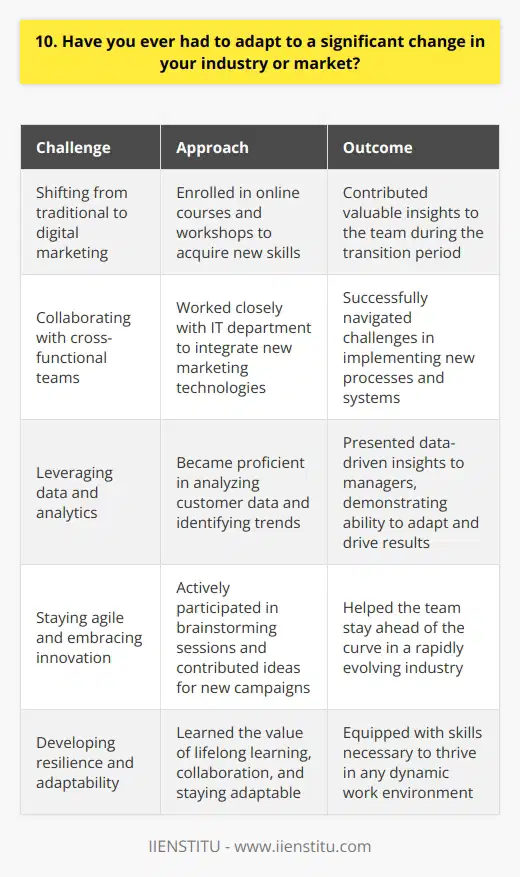
12. How do you maintain a positive attitude during times of uncertainty and change?
Maintaining a positive attitude during times of uncertainty and change is crucial for personal and professional growth. I've found that focusing on the things within my control helps me stay grounded and optimistic. When faced with challenges, I take a step back and assess the situation objectively.
Embrace Change as an Opportunity
Rather than resisting change, I try to view it as an opportunity to learn and adapt. By keeping an open mind and being flexible, I can better navigate the ups and downs. I remember a time when my company underwent a major restructuring, and instead of getting discouraged, I saw it as a chance to take on new responsibilities and expand my skill set.
Practice Gratitude and Mindfulness
I make a conscious effort to practice gratitude, even during difficult times. Taking a moment each day to reflect on the positive aspects of my life helps me maintain a balanced perspective. Mindfulness techniques, like deep breathing and meditation, also help me stay centered and focused on the present moment.
Surround Yourself with Positivity
Surrounding myself with positive and supportive people is another key factor in maintaining a good attitude. I seek out colleagues and mentors who inspire and encourage me. Their guidance and optimism are invaluable during times of uncertainty.
Take Care of Your Well-being
Finally, I prioritize self-care to maintain a positive mindset. Regular exercise, a healthy diet, and sufficient sleep are essential for managing stress and staying energized. When I take care of myself, I'm better equipped to face challenges with resilience and a can-do attitude.
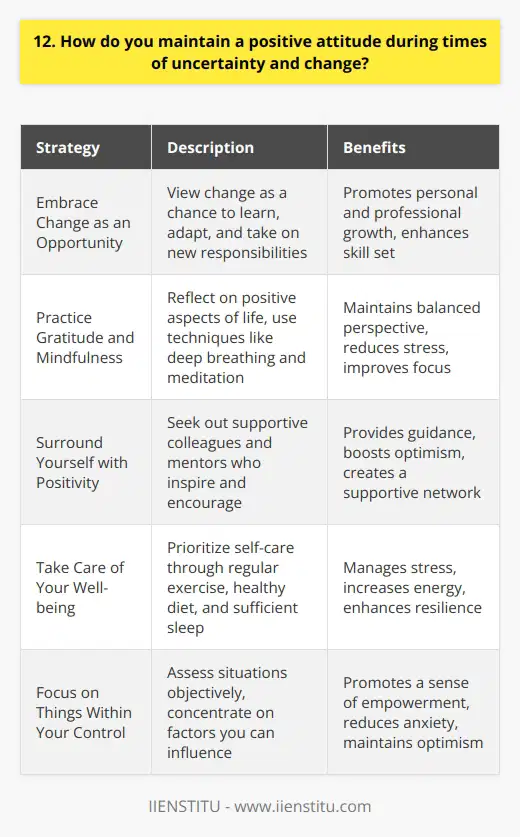
13. Have you ever had to adapt to a new company culture after a merger or acquisition?
Yes, I have experienced adapting to a new company culture following an acquisition. When my previous employer was acquired by a larger firm, I had to quickly learn and adjust to the new organizational structure, communication styles, and expectations.
Embracing Change with a Positive Attitude
I approached the transition with an open mind and a willingness to learn. I viewed it as an opportunity for growth and development, rather than a challenge or obstacle. This positive attitude helped me navigate the changes more smoothly.
Observing and Listening
I took the time to observe how my new colleagues interacted and communicated. I listened carefully during meetings and conversations to understand the nuances of the new company culture. This helped me adapt my own communication style to fit in more effectively.
Building Relationships
I made a conscious effort to build relationships with my new colleagues, especially those in different departments. I sought out opportunities to collaborate on projects and engage in informal conversations. These connections helped me better understand the company's values and norms.
Seeking Guidance and Feedback
I wasn't afraid to ask questions when I needed clarification or guidance. I sought feedback from my manager and peers on how I was adjusting and where I could improve. Their insights were invaluable in helping me align with the new culture.
Overall, adapting to a new company culture after an acquisition required flexibility, curiosity, and a willingness to learn. By embracing change, observing and listening, building relationships, and seeking guidance, I was able to successfully navigate the transition and thrive in my new environment.
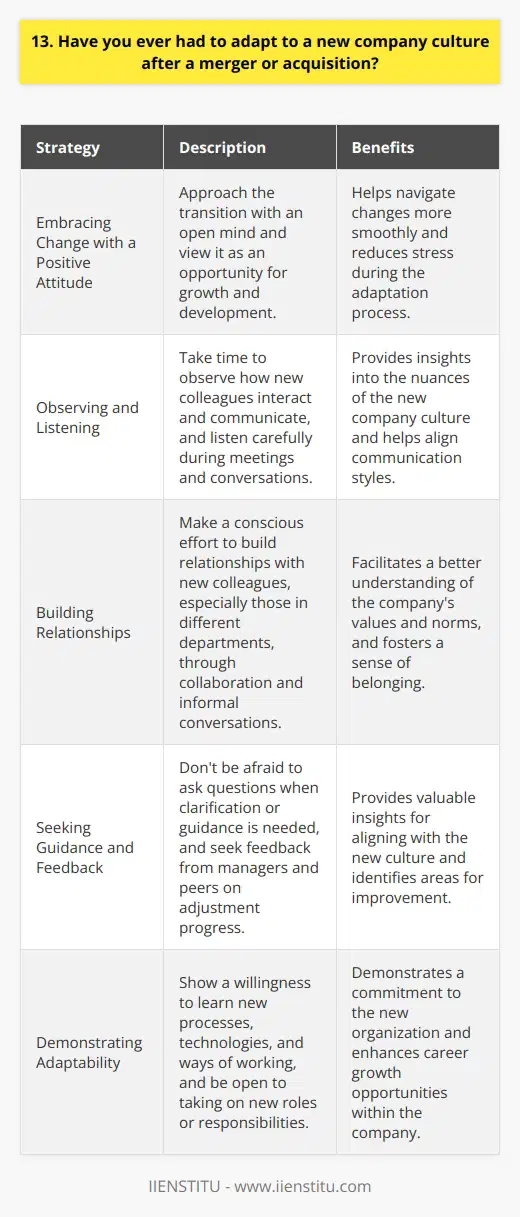
14. Can you describe a time when you had to change your approach to problem-solving?
In my previous role as a software developer, I encountered a complex bug in our system that was causing significant performance issues. Initially, I approached the problem by diving deep into the codebase, trying to identify the root cause through extensive debugging and code analysis.
Changing My Approach
However, after several days of effort, I realized that my current approach was not yielding the desired results. I decided to take a step back and reassess the situation. I reached out to my colleagues and organized a brainstorming session to gather fresh perspectives on the problem.
Collaborating with the Team
During the brainstorming session, we discussed the issue from various angles and shared our insights. One of my teammates suggested looking at the problem from a different perspective, focusing on the system architecture rather than just the codebase.
A Fresh Perspective
This new viewpoint sparked an idea in my mind. I realized that the performance bottleneck might be related to how the different components of the system were interacting with each other. Armed with this insight, I started analyzing the system architecture and identifying potential areas for optimization.
Implementing the Solution
After careful analysis and discussion with the team, we identified a design flaw in the system that was causing the performance issues. We collaborated to develop a plan to refactor the architecture and optimize the interactions between the components.
I took the lead in implementing the necessary changes, and after thorough testing, we successfully resolved the performance bug. The system's response time improved significantly, and user satisfaction increased as a result.
Lessons Learned
This experience taught me the importance of adaptability in problem-solving. Sometimes, our initial approach may not yield the desired results, and it's crucial to be open to exploring alternative perspectives and collaborating with others. By being flexible and willing to change my approach, I was able to find an effective solution to a complex problem.
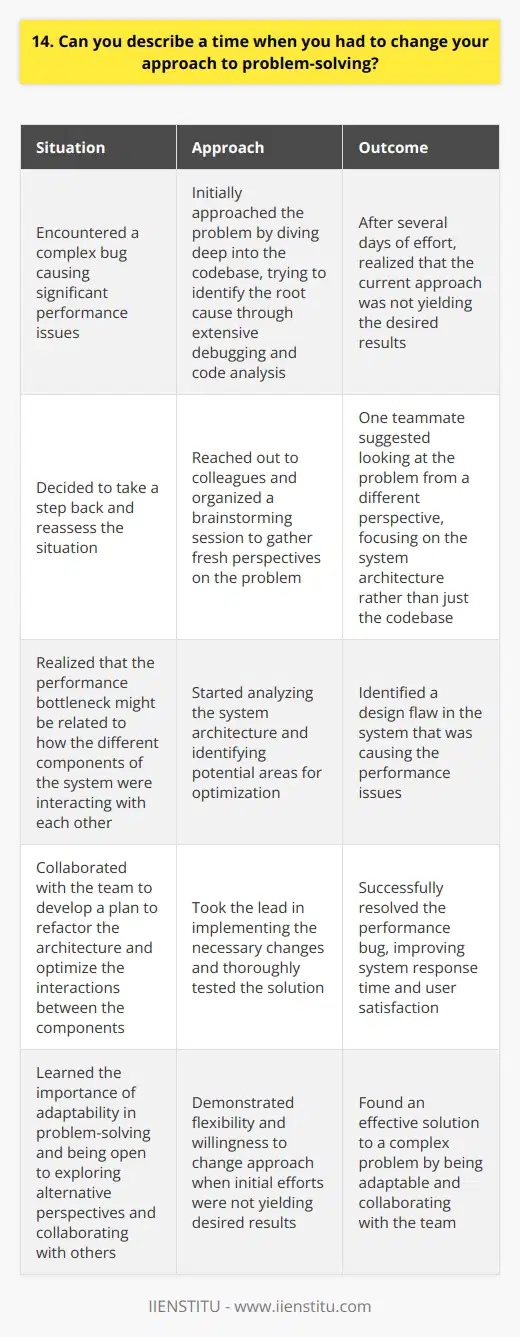
15. How do you stay motivated when faced with major changes in your work environment?
When faced with major changes in my work environment, I find that focusing on the positive aspects of the situation helps me stay motivated. While change can be uncomfortable, it also presents opportunities for growth and learning. By embracing these opportunities, I am able to maintain a sense of excitement and enthusiasm for my work.
Staying Adaptable
One key strategy I use is to remain flexible and adaptable. I try to approach changes with an open mind and a willingness to adjust my approach as needed. This allows me to navigate new challenges more effectively and find creative solutions to problems that arise.
Setting Goals
Another important factor in staying motivated is setting clear goals for myself. When my work environment is changing, I take time to reassess my priorities and identify what I want to achieve in the new context. Having specific, achievable goals gives me a sense of purpose and direction, even in the midst of uncertainty.
Seeking Support
Finally, I find that seeking support from my colleagues and supervisors is crucial during times of change. Talking through my concerns and getting feedback helps me gain perspective and feel more connected to my team. Knowing that I have a strong support system in place gives me the confidence to tackle new challenges head-on.
Overall, staying motivated in the face of major changes requires a combination of adaptability, goal-setting, and seeking support. By approaching changes with a positive attitude and a willingness to learn, I am able to maintain my enthusiasm and drive, no matter what my work environment throws my way.
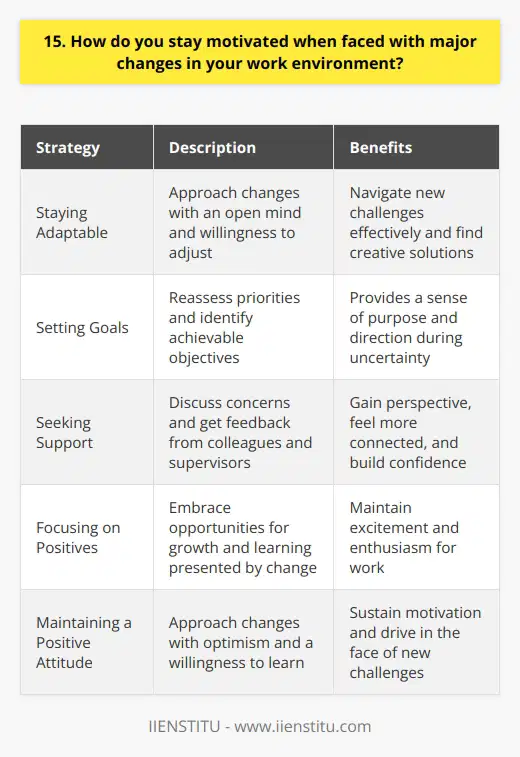
16. Have you ever had to adapt to a new role or position within your company?
Yes, I have adapted to new roles within my company several times. When I first started as a junior marketing associate, I was primarily focused on social media management and content creation.
Taking on New Responsibilities
However, as the company grew, I was asked to take on additional responsibilities in email marketing and SEO. It was challenging at first, but I saw it as an opportunity to expand my skill set and contribute more to the team.
Learning and Growing
I took the initiative to learn as much as I could about these new areas through online courses, attending industry conferences, and collaborating with colleagues who had more experience. Over time, I became more confident in my abilities and was able to make significant contributions to our email and SEO strategies.
Embracing Change
Adapting to new roles has taught me the importance of being flexible, proactive, and always willing to learn. I've found that embracing change and taking on new challenges has not only helped me grow professionally but has also made my work more engaging and fulfilling.
In my current role as a marketing manager, I continue to look for opportunities to expand my knowledge and take on new responsibilities. I believe that being adaptable is essential for success in today's fast-paced business environment.
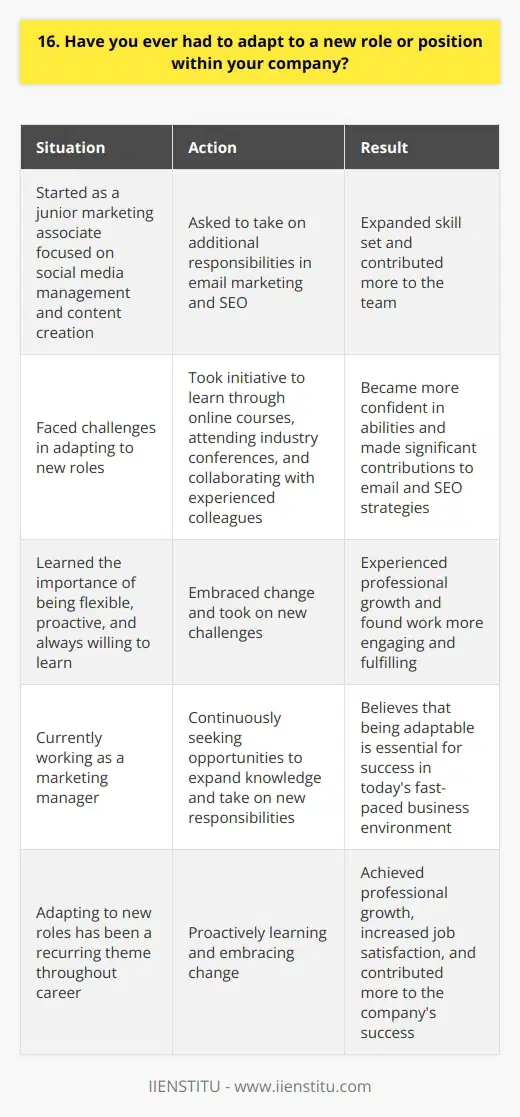
18. How do you maintain strong relationships with colleagues during times of change?
Maintaining strong relationships with colleagues during times of change is crucial for a cohesive work environment. I believe open communication is key. I make an effort to listen actively to my colleagues' concerns and ideas. Empathy goes a long way in understanding different perspectives.
Adapting to Change Together
Change can be challenging, but it's also an opportunity for growth. I try to stay positive and supportive. Working together to adapt to new circumstances strengthens bonds between team members. I remember when our department underwent a major restructuring at my previous job. It was a stressful time, but by collaborating closely, we emerged as an even stronger, more efficient team.
Maintaining Personal Connections
Amidst the busyness of work, I think it's important to make time for casual conversations and team-building. Grabbing coffee together or chatting about weekend plans helps maintain personal connections. Those relationships serve as a foundation of trust and understanding, which is especially valuable during times of change. At my last company, I organized monthly potluck lunches which boosted morale and camaraderie.
Leading by Example
As someone who values teamwork highly, I strive to lead by example in maintaining positive relationships. I make an effort to be approachable, reliable, and supportive, even in challenging times. I believe embodying the spirit of collaboration inspires others to do the same. Together, we can weather any changes that come our way and emerge as a more resilient, adaptable team.
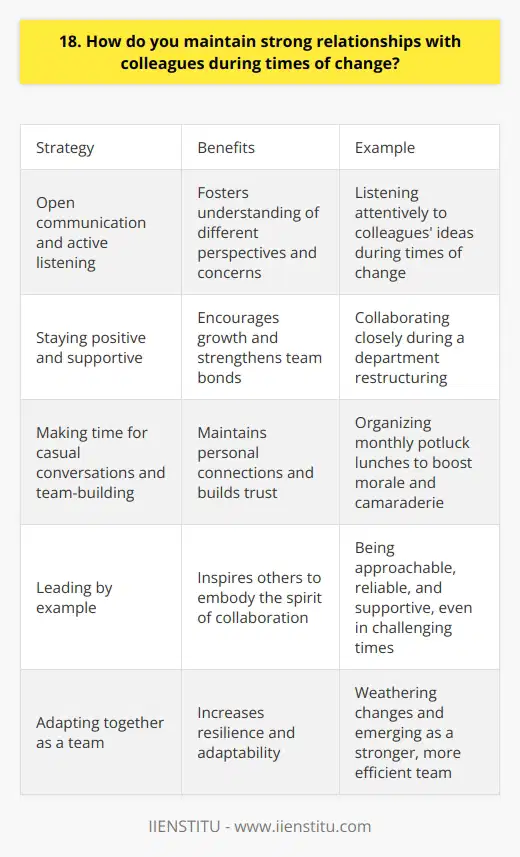
19. Have you ever had to adapt to a new work schedule or shift?
Yes, I've had to adapt to new work schedules and shifts several times throughout my career. It can be challenging at first, but with the right mindset and strategies, it's definitely manageable.
Communication is Key
When starting a new schedule, I always make sure to communicate openly with my supervisor and colleagues. Asking questions, seeking clarification, and expressing any concerns helps ensure a smooth transition.
Prioritize Self-Care
Adapting to a new routine can be tiring, so I prioritize self-care during the adjustment period. This includes getting enough sleep, eating well, and making time for relaxation and hobbies outside of work.
Stay Organized
I find that staying organized is crucial when adapting to a new schedule. I use tools like calendars, to-do lists, and reminders to keep track of my tasks and commitments.
Embrace the Change
Rather than resisting the new schedule, I try to embrace it as an opportunity for growth and development. I focus on the positive aspects, such as the chance to work with new people or take on new responsibilities.
Learn from Others
When adapting to a new shift, I often seek advice from colleagues who have experience with that schedule. They can offer valuable tips and insights on how to manage the transition effectively.
Overall, while adapting to a new work schedule can be challenging, I believe that with the right approach and support, it's an achievable and rewarding experience.
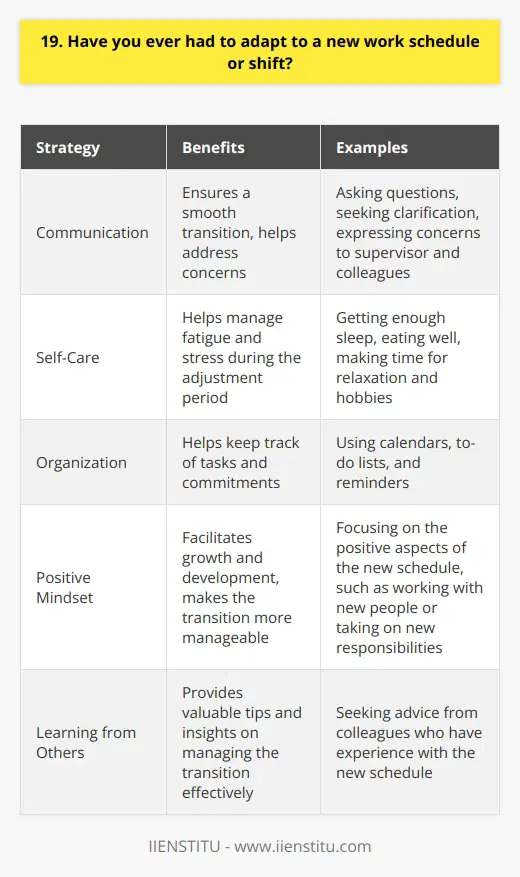
20. Can you describe a time when you had to change your approach to customer service or client management?
In my previous role as a customer service representative, I encountered a challenging situation with a dissatisfied client. The client was frustrated with the product and demanded a full refund, which was against our company policy.
Listening to the Client's Concerns
I took the time to listen to the client's concerns and empathize with their situation. I acknowledged their frustration and assured them that I would do my best to find a solution.
Adapting My Approach
Instead of simply reciting the company policy, I adapted my approach to focus on the client's needs. I asked questions to better understand their specific issues with the product and what they hoped to achieve.
Finding a Creative Solution
Based on the client's feedback, I proposed a creative solution that addressed their concerns while still adhering to company guidelines. I offered a partial refund and a complimentary upgrade to a higher-tier product that better suited their needs.
Building Trust and Rapport
Throughout the process, I maintained a calm and professional demeanor, even when the client expressed their frustration. I focused on building trust and rapport by actively listening, showing empathy, and communicating clearly.
Achieving a Positive Outcome
By adapting my approach and finding a creative solution, I was able to turn a challenging situation into a positive outcome. The client accepted the proposed solution and expressed their appreciation for my efforts to address their concerns.
This experience taught me the importance of being flexible and adaptable in customer service. It's not always about following a script or sticking rigidly to policies, but rather about actively listening to clients, understanding their needs, and finding mutually beneficial solutions.
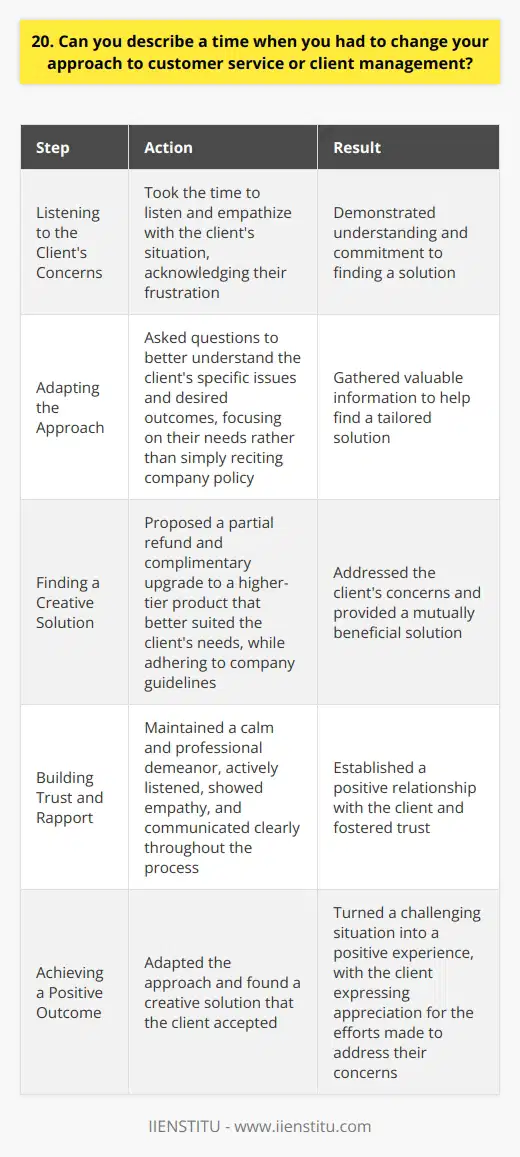
21. How do you ensure that you continue to meet deadlines during periods of transition?
I have a few strategies to ensure I continue meeting deadlines during periods of transition. First, I prioritize my tasks based on urgency and importance. This helps me focus on what needs to be done first.
Communication is Key
I also communicate regularly with my team and manager about my progress and any obstacles I'm facing. If I anticipate missing a deadline, I let them know as soon as possible so we can work together to find a solution. In my last role, we were going through a major reorganization, but I made sure to keep my manager updated on my workload and any challenges I encountered.
Staying Organized
Another important strategy is staying organized. I use project management tools to track my tasks, deadlines, and progress. This helps me stay on top of my work even when things are chaotic. I also break large projects into smaller, manageable tasks, which makes them feel less overwhelming.
Adaptability and Flexibility
Finally, I try to be adaptable and flexible during times of change. I understand that priorities may shift, and I'm willing to adjust my work accordingly. I also take initiative to learn new skills or take on additional responsibilities if needed to support my team. It's not always easy, but I find that staying positive and focused on the end goal helps me navigate transitions more smoothly.
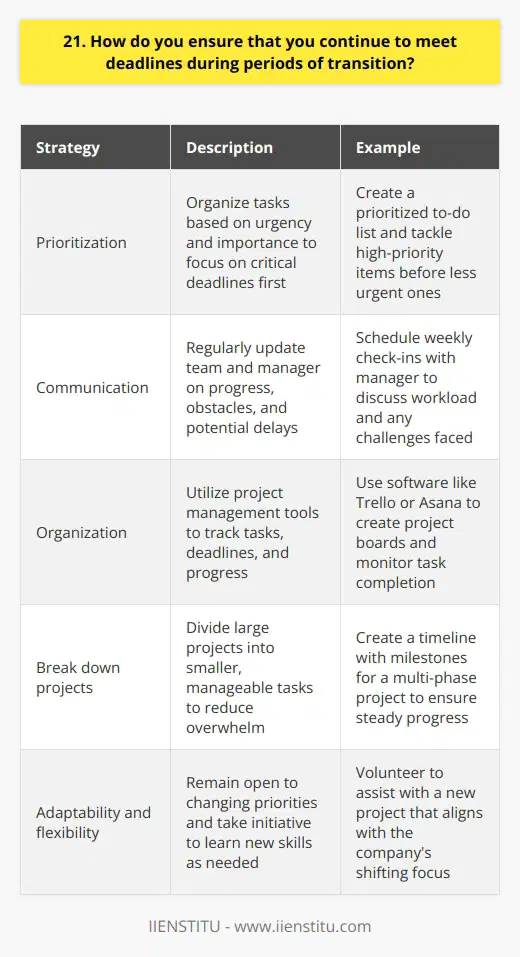
22. Have you ever had to adapt to new performance metrics or evaluation criteria?
Throughout my career, I've encountered numerous situations where I had to adapt to new performance metrics and evaluation criteria. One memorable example occurred when I was working as a marketing coordinator for a tech startup. The company decided to shift its focus from traditional marketing channels to digital marketing, which meant that my role and responsibilities changed significantly.
Embracing the Challenge
At first, I felt overwhelmed by the new expectations and metrics. I had to quickly learn about SEO, social media marketing, and email campaigns. However, I viewed this change as an opportunity for growth and development. I enrolled in online courses, attended workshops, and sought guidance from experienced colleagues to expand my skill set.
Collaborating with the Team
I worked closely with my team to understand the new objectives and align our efforts. We brainstormed ideas, shared insights, and supported each other through the transition. By fostering open communication and collaboration, we were able to adapt more effectively to the new performance metrics.
Achieving Positive Results
As I became more comfortable with the digital marketing strategies, I started to see positive results. Our website traffic increased, leads generated through social media grew, and our email campaigns had higher engagement rates. These improvements not only boosted my confidence but also demonstrated my ability to adapt and thrive in a dynamic work environment.
In conclusion, adapting to new performance metrics and evaluation criteria is an essential skill in today's fast-paced business world. By embracing challenges, continuously learning, and collaborating with others, I have successfully navigated such changes and grown both personally and professionally.
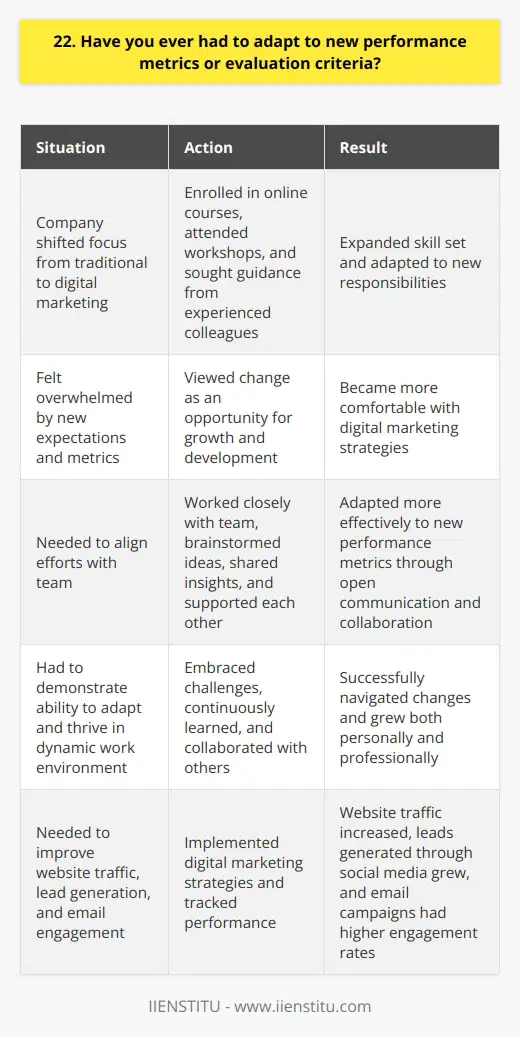
24. How do you maintain a healthy work-life balance during times of significant change?
Maintaining a healthy work-life balance during times of significant change is crucial for both personal and professional well-being. I believe that the key to achieving this balance lies in setting clear boundaries, prioritizing self-care, and communicating effectively with your team and loved ones.
Set Clear Boundaries
When faced with change, it's easy to let work consume your entire life. That's why I make a conscious effort to set clear boundaries between my work and personal time. I establish specific hours for work and stick to them, even if it means saying no to additional tasks or meetings.
For example, during a recent company restructuring, I made sure to leave the office at a reasonable hour each day, despite the increased workload. This allowed me to maintain a sense of normalcy and spend quality time with my family, which helped me stay grounded and focused.
Prioritize Self-Care
In times of change, it's more important than ever to prioritize self-care. I make sure to carve out time for activities that help me recharge and reduce stress, such as exercise, meditation, or pursuing a hobby.
During a particularly challenging project last year, I made a point to go for a short walk during my lunch break every day. This simple act of stepping away from my desk and getting some fresh air helped me maintain a positive outlook and tackle the challenges with renewed energy.
Communicate Effectively
Effective communication is essential for maintaining a healthy work-life balance during times of change. I make sure to keep my team and loved ones informed about my workload and any potential challenges I'm facing.
When my company underwent a major digital transformation, I scheduled regular check-ins with my manager to discuss my progress and any obstacles I encountered. This open communication helped me manage expectations and receive the support I needed to maintain a balanced life.
Stay Adaptable
Finally, I believe that staying adaptable is key to maintaining a healthy work-life balance during times of change. I try to embrace change as an opportunity for growth and learning, rather than resisting it.
When my team shifted to remote work due to the pandemic, I took the opportunity to learn new digital collaboration tools and find creative ways to stay connected with my colleagues. By staying adaptable and open-minded, I was able to maintain a sense of balance and continue delivering high-quality work.
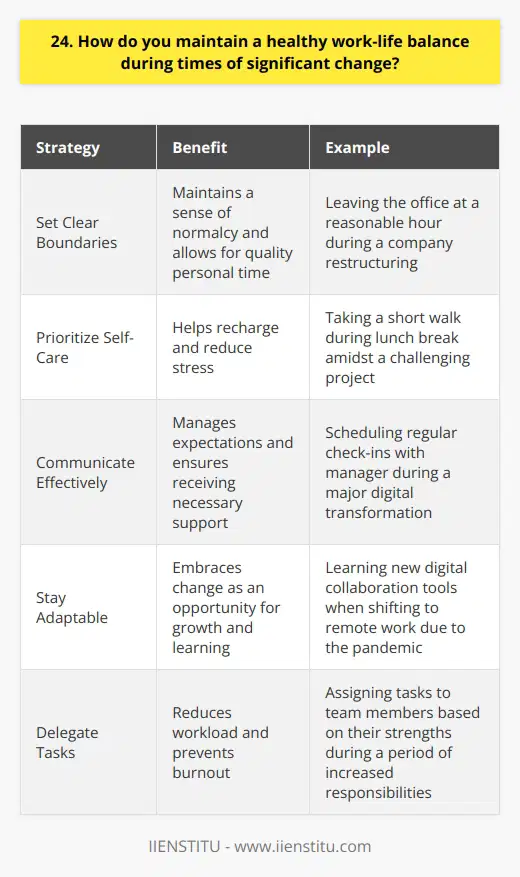
25. Have you ever had to adapt to new compliance regulations or legal requirements in your industry?
As a marketing professional, I've had to adapt to new compliance regulations and legal requirements several times throughout my career. One memorable instance was when the General Data Protection Regulation (GDPR) came into effect in the European Union.
Understanding the New Regulations
When the GDPR was introduced, I took the time to thoroughly read and understand the new requirements. I attended webinars and workshops to ensure I had a solid grasp of the implications for our marketing strategies.
Collaborating with Legal and IT Teams
I worked closely with our legal and IT departments to assess how the GDPR would impact our data collection and processing practices. Together, we identified areas that needed to be updated to ensure compliance.
Implementing Changes in Marketing Strategies
Based on our findings, I led the effort to revise our marketing campaigns and data management processes. We updated our privacy policies, obtained explicit consent from customers, and implemented stricter data security measures.
Communicating with Customers
I also ensured that we communicated the changes to our customers transparently. We sent out emails explaining the updates and reassured them that their data privacy was our top priority.
Staying Proactive and Adaptable
Throughout the process, I learned the importance of staying proactive and adaptable in the face of new regulations. By being willing to learn, collaborate with other teams, and make necessary adjustments, I was able to successfully navigate the challenges posed by the GDPR.
This experience strengthened my ability to adapt to changing legal landscapes while still delivering effective marketing campaigns. It's a skill I continue to apply as new regulations emerge in our industry.

26. Can you describe a time when you had to change your approach to project management?
In my previous role as a project manager, I faced a challenging situation that required me to adapt my approach. The project was falling behind schedule due to unexpected roadblocks and communication breakdowns among team members.
Identifying the Problem
I realized that our current project management methodology wasn't effective in addressing the unique challenges we were facing. The rigid structure and lack of flexibility were hindering our progress and causing frustration within the team.
Researching Alternative Approaches
I took the initiative to research alternative project management methodologies that could potentially better suit our needs. After careful consideration and discussions with my team, we decided to transition to an agile approach.
Implementing Agile Methodology
Switching to agile project management allowed us to break down the project into smaller, manageable sprints. We held daily stand-up meetings to foster better communication and collaboration among team members. This change enabled us to quickly identify and address issues as they arose.
Encouraging Adaptability and Continuous Improvement
I encouraged my team to embrace the agile mindset of adaptability and continuous improvement. We regularly held retrospective meetings to reflect on our progress, identify areas for enhancement, and make necessary adjustments to our processes.
Positive Outcomes
By changing our approach to project management, we were able to get the project back on track. The increased transparency, collaboration, and flexibility resulted in improved productivity and morale within the team. We successfully delivered the project within the revised timeline and received positive feedback from stakeholders.
This experience taught me the importance of being open to change and adapting project management approaches when necessary. It also strengthened my problem-solving skills and ability to lead teams through challenging situations.
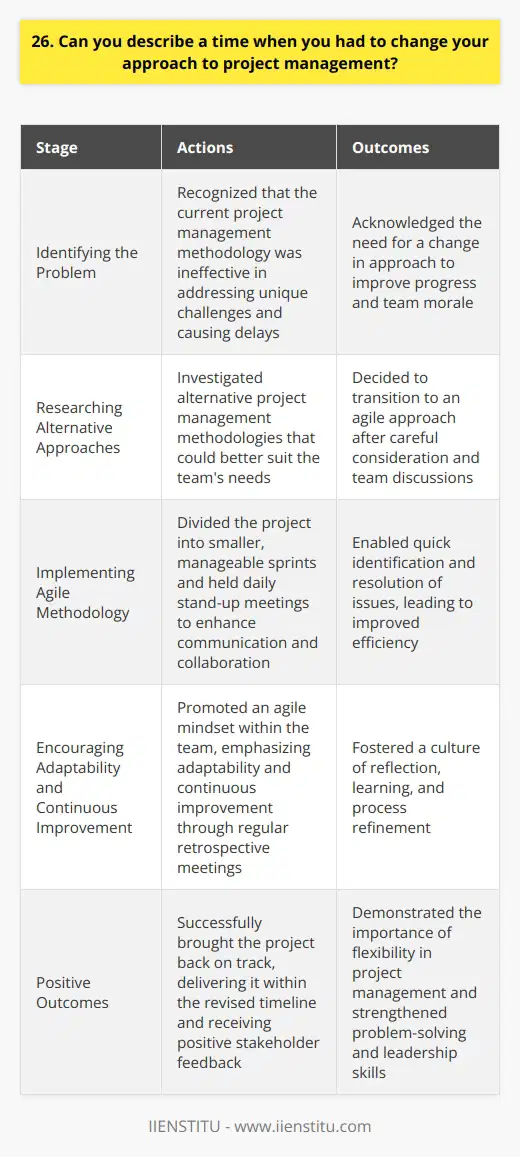
27. How do you ensure that you continue to develop your skills and knowledge during times of change?
I believe that continuous learning is essential for personal and professional growth, especially during times of change. I make it a point to stay curious and open-minded, always seeking out new opportunities to expand my knowledge and skills. Whether it's attending industry conferences, enrolling in online courses, or collaborating with colleagues on innovative projects, I'm constantly looking for ways to challenge myself and stay ahead of the curve.
Embracing Change as an Opportunity
Rather than viewing change as a threat, I see it as an exciting opportunity to learn and grow. When faced with new challenges or unfamiliar situations, I dive in headfirst, eager to explore different perspectives and approaches. I've found that by embracing change with a positive attitude, I'm better equipped to adapt and thrive in dynamic environments.
Building a Strong Network
Another key aspect of my personal development strategy is building a strong network of mentors, peers, and industry experts. I regularly reach out to colleagues and thought leaders in my field, seeking their insights and advice. These conversations not only help me stay up-to-date on the latest trends and best practices but also provide valuable opportunities for collaboration and skill-sharing.
Applying Learning in Real-World Situations
Of course, learning is only valuable if it can be applied in real-world situations. That's why I make a conscious effort to put my newfound knowledge and skills into practice whenever possible. Whether it's volunteering for stretch assignments at work or taking on side projects in my free time, I'm always looking for ways to test my abilities and push myself outside my comfort zone.
By staying curious, embracing change, building a strong network, and applying my learning in practical ways, I'm confident that I can continue to develop my skills and knowledge, no matter what challenges come my way.
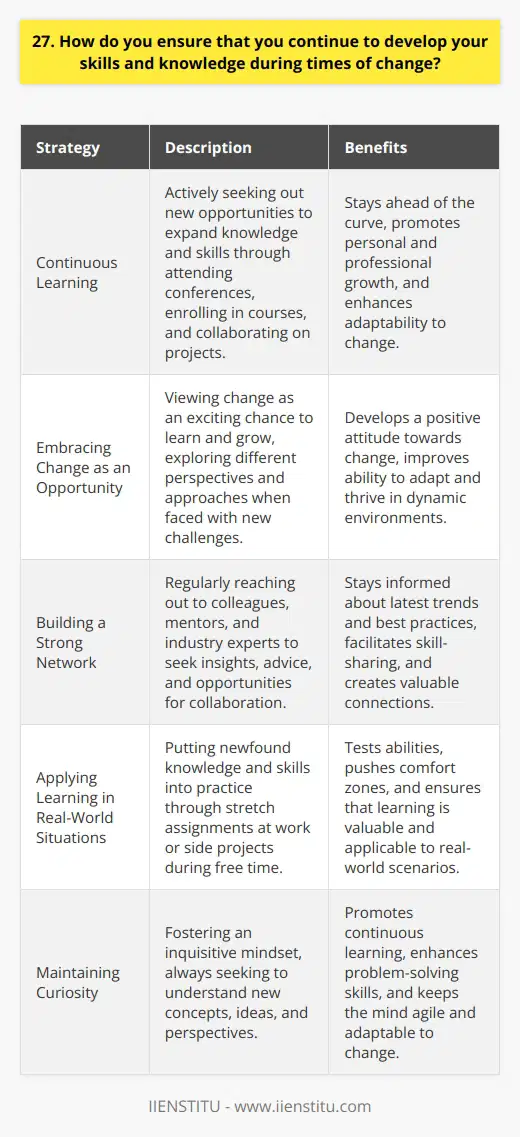
28. Have you ever had to adapt to new budgetary constraints or financial targets?
Throughout my career, I've faced situations where I had to adapt to new budgetary constraints and financial targets. One memorable example was when I worked as a marketing coordinator at a startup. Our company experienced a sudden shift in priorities, which meant we had to reevaluate our marketing budget.
Assessing the Situation
When the new financial targets were announced, I took a step back to assess the situation. I analyzed our current marketing initiatives and their impact on our overall goals. This helped me identify areas where we could potentially reduce spending without compromising the effectiveness of our campaigns.
Collaborating with the Team
I collaborated closely with my team members to brainstorm creative solutions. We explored alternative marketing channels and strategies that could deliver similar results at a lower cost. By pooling our ideas and expertise, we were able to come up with a revised marketing plan that aligned with the new budgetary constraints.
Prioritizing and Optimizing
To adapt to the new financial targets, I prioritized our marketing efforts based on their potential impact and ROI. I focused on the initiatives that had proven to be most effective in the past and optimized them further. This involved negotiating better rates with vendors, leveraging free or low-cost marketing tools, and finding ways to maximize our resources.
Monitoring and Adjusting
Throughout the process, I closely monitored our marketing performance and made data-driven decisions. I regularly reviewed our metrics and made adjustments as needed to ensure we were on track to meet our goals within the new budget. This agile approach allowed us to adapt quickly to any changes and optimize our strategies in real-time.
Adapting to new budgetary constraints and financial targets can be challenging, but it also presents an opportunity for growth and innovation. By assessing the situation, collaborating with my team, prioritizing our efforts, and continuously monitoring and adjusting, I was able to successfully navigate the changes and deliver strong results for the company.
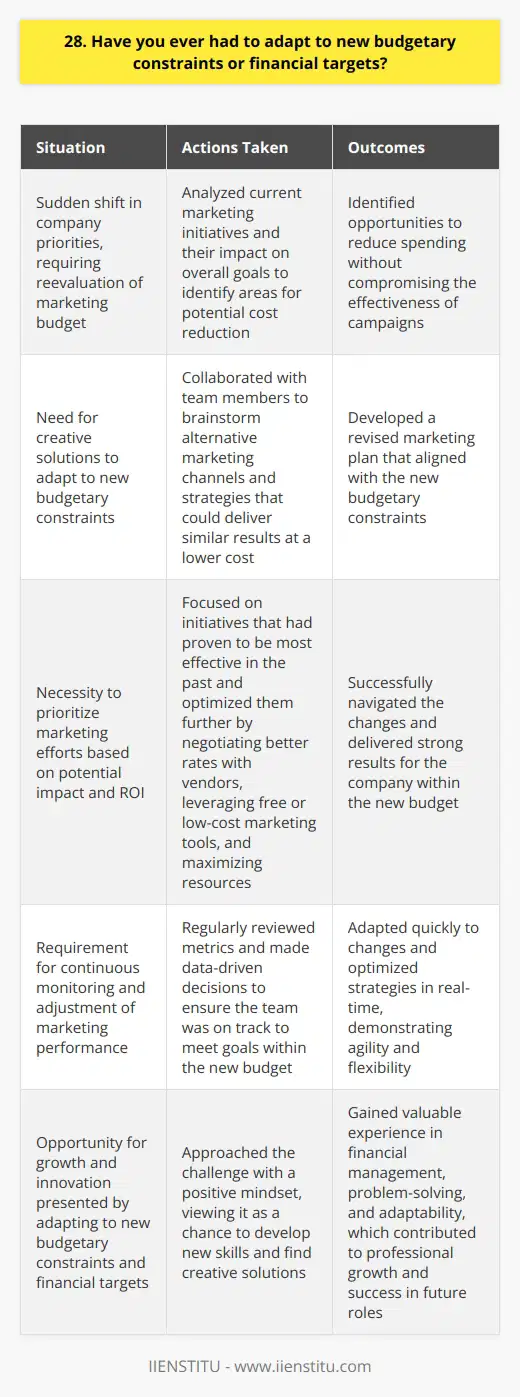
30. How do you maintain a strategic focus while adapting to operational changes?
Maintaining a strategic focus while adapting to operational changes is a crucial skill in today's fast-paced work environment. I believe that effective communication and collaboration with team members are key to staying aligned with long-term goals.
Prioritize and Plan
When faced with operational changes, I first assess their impact on our strategic objectives. I prioritize tasks and adjust my plan accordingly, ensuring that critical initiatives stay on track.
Stay Agile and Flexible
I've learned to embrace change and remain agile in my approach. I'm always ready to adapt my strategies and tactics when needed, without losing sight of the bigger picture.
Communicate and Collaborate
Open communication with my team is essential. I make sure everyone understands how operational changes affect our goals. We work together to find solutions and keep each other informed.
Learn and Grow
Every challenge is an opportunity to learn and improve. I reflect on how I handled operational changes and identify areas for growth. This helps me become more resilient and adaptable over time.
In my previous role, we faced a sudden shift in client requirements mid-project. By quickly reassessing priorities, collaborating with my team, and adjusting our approach, we successfully delivered the project while staying true to our strategic vision.
